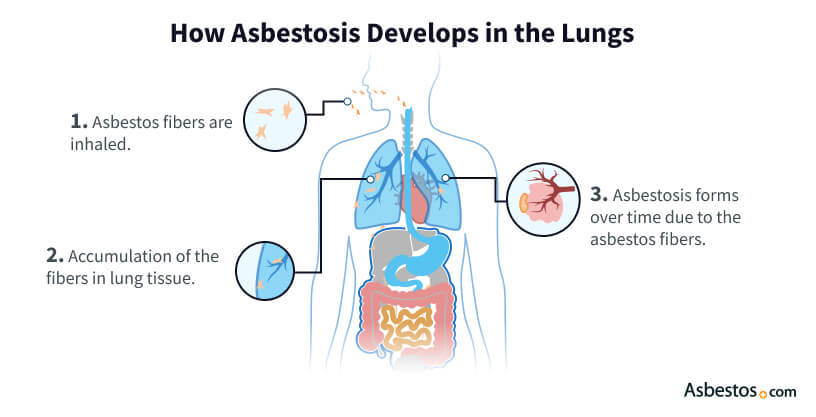Asbestosis
Asbestosis is a lung disease caused by inhaling asbestos fibers. Shortness of breath, a dry cough and chest pain are the most common symptoms. Eating a well-balanced diet and staying hydrated are ways to manage these symptoms.
Written by Karen Selby, RN • Edited By Walter Pacheco • Medically Reviewed By Dr. Raja Michael Flores
Asbestos.com is the nation’s most trusted mesothelioma resource
The Mesothelioma Center at Asbestos.com has provided patients and their loved ones the most updated and reliable information on mesothelioma and asbestos exposure since 2006.
Our team of Patient Advocates includes a medical doctor, a registered nurse, health services administrators, veterans, VA-accredited Claims Agents, an oncology patient navigator and hospice care expert. Their combined expertise means we help any mesothelioma patient or loved one through every step of their cancer journey.
More than 30 contributors, including mesothelioma doctors, survivors, health care professionals and other experts, have peer-reviewed our website and written unique research-driven articles to ensure you get the highest-quality medical and health information.
About The Mesothelioma Center at Asbestos.com
- Assisting mesothelioma patients and their loved ones since 2006.
- Helps more than 50% of mesothelioma patients diagnosed annually in the U.S.
- A+ rating from the Better Business Bureau.
- 5-star reviewed mesothelioma and support organization.
Testimonials
My family has only the highest compliment for the assistance and support that we received from The Mesothelioma Center. This is a staff of compassionate and knowledgeable individuals who respect what your family is experiencing and who go the extra mile to make an unfortunate diagnosis less stressful. Information and assistance were provided by The Mesothelioma Center at no cost to our family.LashawnMesothelioma patient’s daughter
How to Cite Asbestos.com’s Article
APA
Selby, K. (2024, January 17). Asbestosis. Asbestos.com. Retrieved April 18, 2024, from https://www.asbestos.com/asbestosis/
MLA
Selby, Karen. "Asbestosis." Asbestos.com, 17 Jan 2024, https://www.asbestos.com/asbestosis/.
Chicago
Selby, Karen. "Asbestosis." Asbestos.com. Last modified January 17, 2024. https://www.asbestos.com/asbestosis/.
What Is Asbestosis?
Asbestosis is a serious lung condition that develops because of exposure to asbestos and involves progressive scarring of lung tissue. Exposure in construction sites, ships and industrial facilities has caused many asbestosis cases.
Asbestosis is one of many interstitial lung diseases that cause inflammation and scarring in the lungs. Inhaled asbestos fibers can cause scar tissue, known as pulmonary fibrosis, to form within the lungs.
- Incurable lung disease that makes breathing progressively more difficult
- Usually because of years of occupational asbestos exposure
- A contributing cause of death for approximately 600 to more than 1,000 Americans each year
- Signifies an elevated risk of developing asbestos-related cancer
When dust from sources such as asbestos causes this type of disease, it’s known as occupational lung disease or pneumoconiosis. There is no cure for asbestosis, but treatment can alleviate symptoms and slow disease progression.
Asbestosis is not a cancerous disease. However, it indicates a patient experienced enough exposure to be at risk of developing cancer. These include asbestos-related lung cancer and pleural mesothelioma. The chance of developing lung cancer after an asbestosis diagnosis is higher than the risk of developing malignant mesothelioma.
Asbestosis Symptoms
When scar tissue forms around the lungs’ microscopic air sacs, known as alveoli, it gradually becomes harder for them to expand and fill with fresh air. The first symptoms of asbestosis include a dry cough, difficulty breathing and crackling sounds when breathing.
- Shortness of breath
- Persistent dry cough
- Chest tightness and pain
- Fatigue
- Loss of weight and appetite
- Crackling sounds when breathing
- Clubbing of fingers and toes
Scarring causes lung tissue to stiffen. This leads to coughing, discomfort and crackling sounds associated with asbestosis. It also results in less oxygen in the blood, causing shortness of breath. Chronic breathing difficulties and reduced oxygen lead to fatigue and weight loss.
Advanced Asbestosis Symptoms
Advanced symptoms include pulmonary hypertension and clubbed fingers and toes. The formation of scar tissue can constrict arteries and cause pulmonary hypertension. When it’s harder for the body to pump blood out of the heart and into the lungs, blood pressure increases to perform the action.
When the lungs deliver insufficient oxygen to the blood, a symptom called “clubbing” may arise. The tips of the toes and fingers appear wider and rounder than normal. This symptom may appear early in disease progression for some patients.
Asbestosis takes less time to develop than asbestos-related cancer. An asbestosis diagnosis signals a risk of developing lung cancer or mesothelioma in the future.

Asbestosis Causes
The only cause of asbestosis is exposure to asbestos. Different types of dust can cause other types of pneumoconiosis. For example, silicosis is a form of pneumoconiosis due to exposure to silica dust.
Inhalation of asbestos fibers leads to a buildup of the fibers in lung tissue. Over time, asbestos fibers accumulate and cause inflammation and fibrous changes to lung tissue. This process leads to scarring and restrictive tissue movement. The interstitium, alveoli air sacs and surrounding tissue become inflamed and fibrotic.

For an asbestos-related illness to develop, it usually takes years of regular asbestos exposure. The latency period from exposure to symptoms and diagnosis can be decades. Asbestosis has a shorter latency period of 20 to 30 years compared to asbestos-related cancers, which average 20 to 50 years.
People who experienced occupational asbestos exposure are at higher risk of asbestosis. Asbestosis tends to develop in people who were exposed to large amounts of asbestos over long periods of time.
Risk factors that affect asbestosis development include:
- Amount and concentration of asbestos
- Size, shape and type of asbestos fibers
- Length of time of the exposure to asbestos
- Health factors such as smoking or a history of lung disease
- Genetic factors or specific mutations in DNA that increase risk of disease
Certain workers were most likely to experience heavy exposure. They include construction workers, insulators who installed spray-on asbestos insulation, asbestos miners and millers. Other workers at high risk include pipefitters, mechanics, boiler workers, textile mill workers, industrial workers and shipyard workers, according to a 2021 study published in the American Journal of Industrial Medicine.

Diagnosing Asbestosis
Diagnosing asbestosis requires thorough medical and occupational histories in addition to medical testing. Doctors use imaging scans, lung function tests and medical and occupational histories to diagnose asbestosis.
Patients typically go to the doctor with breathing problems and undergo an X-ray or CT scan in addition to lung function tests. Radiologists often diagnose this condition because imaging scans reveal the signs of the disease. Doctors consider an asbestosis diagnosis when imaging results and asbestos exposure history align.
Another diagnostic procedure is a biopsy through bronchoscopy. It involves inserting a scope down the throat and windpipe and into the airways of the lungs. A biopsy is generally not necessary when imaging reveals signs of asbestosis in patients with heavy asbestos exposure. Discovering asbestos fibers in sputum or biopsies can also contribute to an asbestosis diagnosis. However, that alone is not enough to diagnose the condition.
Prognosis for Asbestosis
The median survival for all patients diagnosed with asbestosis is approximately 10 years. Life expectancy with asbestosis correlates to disease progression. This means that survival time is longest for stage 1 patients and shortest for stage 3 patients. Those diagnosed in stage 1 live about 14 years compared to stage 3 patients, who live an average of 1.75 years.
| Asbestosis Stage | Survival in Months (Years) |
|---|---|
| Stage 1 | 171 months (14.25 years) |
| Stage 2 | 50 months (4.16 years) |
| Stage 3 | 21 months (1.75 years) |
| All Stages Combined | 124 months (10.3 years) |
The outlook for patients with asbestosis depends on how quickly the condition progresses. How much asbestos exposure they experienced influences this timeline. Those who endured a high level of exposure will typically have more severe disease that may progress to a later stage quickly. Patients with a lower level of exposure may develop a mild case that progresses slowly or not at all.
Only a lung transplant for asbestosis can stop the disease. There is no other cure or way to reverse the scarring caused by asbestos exposure. Asbestosis is the most frequently reported cause of pneumoconiosis deaths. It accounts for about 60% of pneumoconiosis deaths recorded from 1999 to 2018.
Can You Live with Asbestosis?
Yes, you can live with asbestosis for years, but there is no cure for this progressive condition. Patients live an average of 10 years with asbestosis.
Lung transplantation is the best long-term treatment for asbestosis, but few patients qualify for this serious procedure. Other treatments help to control symptoms and slow progression of the disease.
Asbestosis Treatment Options
Asbestosis is an irreversible condition. Except for lung transplantation, all asbestosis treatment options are palliative, meaning they address the symptoms of asbestosis to improve the patient’s quality of life.
Treatments include supplemental oxygen, medications and pulmonary rehabilitation. Supplemental oxygen from a portable oxygen tank is often necessary for patients with reduced lung capacity. Medications can thin lung secretions to make coughing easier and relieve chest pain.
Pulmonary rehabilitation helps patients learn techniques and make lifestyle changes. This helps patients to better cope with chronic breathing difficulties. A team of therapists work together to provide for both physical and psychological needs. Exercise therapy helps patients with physical fitness and lung function. It also improves the quality of life.
Top Pulmonologists Treating Asbestosis
Because the condition gets worse over time, patients require increased treatment as they age. Working with a doctor who specializes in asbestosis treatment is important in controlling disease progression and symptoms.
Lung transplants are most often considered when asbestosis is severe or patients also have other lung diseases such as emphysema. This is a highly invasive, last-resort treatment.
- How advanced is my condition?
- What is the best treatment for asbestosis?
- What medications do you recommend, and what are the side effects?
- How much experience do you have managing asbestosis?
- Will I need a lung transplant?
- Am I at risk of developing mesothelioma or lung cancer?
- Is anyone in my family at risk?
Some patients also find relief through complementary therapies such as acupuncture, massage therapy and nutritional medicine. Lifestyle changes may improve how you feel with asbestosis. For example, quitting smoking will slow progression of the disease. Eating a healthy diet and getting regular exercise and plenty of sleep will help your body cope with the effects of asbestosis, including reduced oxygen intake.
- How long can you live with asbestosis?
-
Unlike mesothelioma, asbestosis is considered a chronic disease. Patients with an asbestosis diagnosis often live for several decades. However, the disease can be deadly, and many asbestosis patients suffer from severe respiratory issues.
- What is the difference between asbestosis and mesothelioma?
-
Mesothelioma is cancer that forms in the mesothelial tissue surrounding the lungs, chest cavity and abdomen. Asbestosis is not cancer but a chronic respiratory disease and a type of pulmonary fibrosis. Asbestosis and mesothelioma have the same cause as other asbestos-related diseases.
- Can asbestosis be cured?
-
There is no cure for asbestosis. Asbestosis treatment options focus on reducing symptoms and improving breathing ability.








